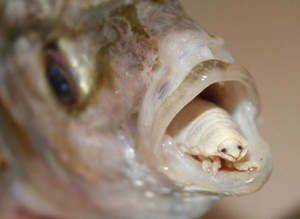Monster Monday: The Tongue-eating Louse
Monday, July 18th, 2016July 18, 2016
It lives in your mouth, slicing your tongue with its razor-sharp jaws and sucking up blood. After your tongue withers away, it takes its place. You can only be thankful it stays, since you would slowly starve if it left. It is a tongue-eating louse, and, if fish could dream, it would haunt their nightmares.
The tongue-eating louse (Cymothoa exigua) is a parasitic marine isopod that infests the mouths and gill cavities of fish. A parasite is a living thing that feeds off another living thing, called a host. An isopod is a type of crustacean that commonly has seven pairs of legs. Tongue-eating lice are known to infest several kinds of fish, but their primary host is snapper.
Tongue-eating lice larvae swim into a fish’s gills and grow there, feeding on the animal’s blood, skin cells, and mucus. As they grow, the largest louse in the fish migrates into the fish’s mouth, anchoring itself with its strong legs. It then pierces the tongue with its sharp jaws and drinks the blood. Eventually, the tongue withers away because of a lack of blood. Rather than let its host die, the louse instead takes the place of the fish’s tongue, helping to hold prey in the fish’s mouth. The louse may continue to feed on blood or grab stray scraps of food, or it might not feed at all once it has reached full size. There are many species of isopods that parasitize fish, but Cymothoa exigua is the only one known to consume and replace a fish’s tongue.
All tongue-eating lice are born male. At some point during the process of destroying the tongue, the largest louse transforms to a female, and the smaller male lice mate with it. Researchers think the female only releases its larvae when the host fish is near other potential hosts, such as when fish swim in schools. Scientists are not sure what the female louse does after the next generation is sent out to infest more fish. Most marine isopods generally give birth to only one brood, so the female probably dies shortly after the larvae are released. Most marine biologists suspect that the fish slowly starves to death once its replacement tongue is gone, unable to effectively hold struggling prey in its mouth. It is possible, however, that another male living in the gills takes the female’s place (and sex), functionally becoming the fish’s new tongue.
Two things are certain. First, more work must be done to study this bizarre animal. Like other marine isopods, the tongue-eating louse infests several kinds of fish that people catch and eat. Consequently, it is important to understand the louse’s life cycle and any negative effects it has on its host. Second, we can thank our lucky stars the tongue-eating louse doesn’t infest humans!



